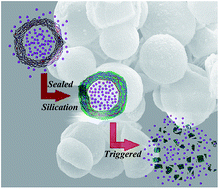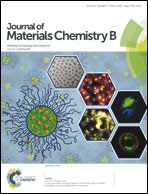Composite silica nanoparticle/polyelectrolyte microcapsules with reduced permeability and enhanced ultrasound sensitivity†
Abstract
Many chemical and biomedical systems require delivery and controlled release of small molecules, which cannot be achieved by conventional polyelectrolyte-based layer-by-layer capsules. This work proposes an innovative hybrid microcapsule by incorporating in situ formed silica nanoparticles within or on the shell. The influence of various experimental conditions on the stability, mechanical strength and morphology of capsules was investigated and characterised by SEM, TEM, XRD, EDX and FTIR. The multifunctional capabilities of the formed capsules were examined by encapsulating a small molecule rhodamine B (Rh-B) which could be further released by an ultrasonic trigger. The results show that in situ formed SiO2 nanoparticles through hydrolysis greatly reduced the permeability of the shell yet showed increased mechanical strength and ultrasound response. SiO2 nanoparticles were shown to be distributed on the surface or inside the polyelectrolyte shell, acting as supports for free-standing capsules in both liquid and dry environments. Rapid Rh-B molecule release and the fragmentation of the capsule shells were observed under 50 W ultrasound irradiation for a few seconds. Such innovative capsules with the capability of small molecule encapsulation and high ultrasound sensitivity could be promising for many applications where pulse release of small molecules is required.

- This article is part of the themed collection: Highlighting materials research in the UK for biology and medicine

 Please wait while we load your content...
Please wait while we load your content...